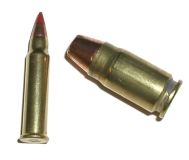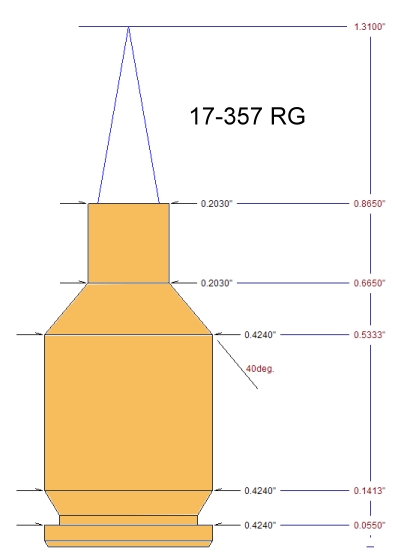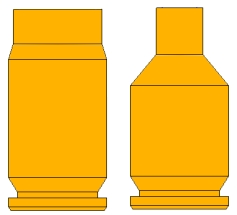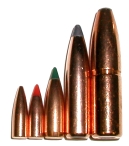 I was staring at a couple of 17 HMR and 357 SIG cartridges, while trying to scrape some recently fallen tuna and mayo off of my keyboard, when my brain merged the images of the two rounds into what looked like a miniature WSM. I opened RCBS.Load and QuickLOAD, working different case configurations and powder alternatives, until I realized there was potential for a nifty 17-357 RG cartridge. Before I get a pile of email advising me that Kit Coyote, the famous Shooting Guns editor made the same cartridge in ’03, I would like to go on record saying I don’t care, and Kit is welcome to the fame he deserves from the original effort. In fact, there are a number of .172 cartridges out there, some with similar capacity cases.
I was staring at a couple of 17 HMR and 357 SIG cartridges, while trying to scrape some recently fallen tuna and mayo off of my keyboard, when my brain merged the images of the two rounds into what looked like a miniature WSM. I opened RCBS.Load and QuickLOAD, working different case configurations and powder alternatives, until I realized there was potential for a nifty 17-357 RG cartridge. Before I get a pile of email advising me that Kit Coyote, the famous Shooting Guns editor made the same cartridge in ’03, I would like to go on record saying I don’t care, and Kit is welcome to the fame he deserves from the original effort. In fact, there are a number of .172 cartridges out there, some with similar capacity cases.
The .17-22 Hornet Ackley Improved with a 13.7 grain capacity case, the .17 Bumble Bee with 9.2 grains of capacity, and the modified .30 carbine case .17 Pee Wee with 14.4 grains of capacity all have been with us for a long time. My interest in a 17-357 RG is related to its short length, its large diameter rimless case and perhaps a different pressure curve than the other noted cartridges.
The Design

No, this is not actual size, but it might help you develop a feel for the real thing. It is a 357 SIG, or 40 S&W necked down to .172″ caliber.
The shoulder has been set back a bit and changed to a 40 degree angle, the case headspaces on the shoulder.
If you handload the 357 SIG, you know it has minimal surface area gripping the bullet. This case configuration will provide .200″ of neck length which is substantial for the .172″ diameter bullet and should hold all bullet weights 30 grains and below, adequately.
Powder capacity is about 12.5 grains, below the neck, which should be more than I need for a short barrel application. If my calculations hold up, and my powder selections, I think the 17-357 RG will be good for 2,000 fps out of a 4″ barrel and about 3,000 fps out of a 15″ barrel. At some point in time, the 17-357 RG might find it’s way into a relatively short barrel varmint rifle where I believe 3,500 fps is a real potential. Fortunately, I have a lot of 357 SIG brass to work with over the next few months.
You’d think a tiny case would be less work….
…but it isn’t really. Primary ingredients to this type of process are knowledge and experience. I quickly came to the realization I had only limited amounts of both but, to my credit, I knew where to find them in abundance. You’ll frequently see me reference CH4D in the context of dies and handloading tools and accessories. Dave Davidson’s shop has a lot to offer, including friendly guidance and helpful information. The 17-357 RG is a different flavor of wildcat cartridge for me. More than simply necking up or down or blowing out a case, the 17-357 RG requires significant reshaping of brass, a task I could not have approached without assistance.
 Changing a small 357 SIG (Left) case into a 17-357 RG (Right) requires finesse. There are a number of areas to consider. Cartridge brass needs to be coaxed into shape in small increments. What are the appropriate increments? I don’t exactly know, and I don’t think there is a rigid rule to follow. Generally, one caliber size change is not a big deal, maybe one and one half is reasonable. I make .358-378 RG brass out of .378 Weatherby and .338-378 Weatherby brass all the time without much effort. I’ve also frequently committed the crime of changing 40 S&W brass into 357 SIG cases in a simple resizing operation. The degree of change across these examples is quite different. .017″ reduction to 378 brass, .020″ expansion to the .338-378 brass and .045″ reduction to the 40S&W brass. The latter is the equivalent to the non-stop neck down of a .308 Winchester case to a .260 Remington. So the answer regarding acceptable increments of change varies.
Changing a small 357 SIG (Left) case into a 17-357 RG (Right) requires finesse. There are a number of areas to consider. Cartridge brass needs to be coaxed into shape in small increments. What are the appropriate increments? I don’t exactly know, and I don’t think there is a rigid rule to follow. Generally, one caliber size change is not a big deal, maybe one and one half is reasonable. I make .358-378 RG brass out of .378 Weatherby and .338-378 Weatherby brass all the time without much effort. I’ve also frequently committed the crime of changing 40 S&W brass into 357 SIG cases in a simple resizing operation. The degree of change across these examples is quite different. .017″ reduction to 378 brass, .020″ expansion to the .338-378 brass and .045″ reduction to the 40S&W brass. The latter is the equivalent to the non-stop neck down of a .308 Winchester case to a .260 Remington. So the answer regarding acceptable increments of change varies.
Dave, offered a rule of thumb to use when determine step increments of case forming. He was also quick to note specific determination would have to take into account what surfaces of the case were being formed, what stresses were being exerted and what were the characteristics of the material. Not so much as a representation of a rigid formula to follow, this is an illustration of the changing conditions that develop as cases are formed.
Neck OD / [10+((shoulder angle – 25)/3)] = Increment
Step 1 .381 / [10+((18-25)/3) = .0497″
Step 2 .331 / [10+((35-25)/3) = .0248″
Step 3 .306 / [10+((40-25)/3) = .0204″
In reality, the progression isn’t linear, the ever diminishing increments would eventually reach the handloader’s equivalent of black hole singularity. In a non Star Trek universe, the project requires 6 forming dies, a sizer, a seater and a reamer die; about 3 more than a turret head full. My guess is that I will need to anneal brass part way through the process, as it work hardens and becomes fracture prone when bent, pushed or shoved a few times. Proper annealing returns the brass to a properly tempered state and allows it to be worked further without splitting. This is something that will require a degree of experimentation after the dies are delivered. In any event, CH4D production lead time and cost were more than reasonable so I placed an order for the die set. Since they are such a reliable shop, I was able to move on to other areas of the project, confident the dies would be completed without a need for continual follow up.
Other dimensions and cutting chambers
The last item on the die list, the reamer die is also something a little different for me. A significant degree of necking size reduction results in a build up of brass, a ring of undersized material at the interior intersection of the case neck and shoulders. I do have a pilot/reamer for my lathe type trimmers, but this type of reamer would only cut following the existing inside neck opening and not necessarily make it parallel to the outside neck surface. A reamer die locates to the outside of the case neck, the same surface that controls alignment of the case in the chamber, and clears the inside of the case neck to this alignment. I expect I will try both methods as well as some outside neck turning to get a uniform cylindrical case neck. Which takes us to the next issue, the neck diameter.
Most .172 caliber cartridges have an outside case diameter of .199″. When case necks are reduced in size, the brass wall thickens, the increase proportional to the degree of change. Following recommendations from CH4D, I had the reamer made to cut the chamber for a nominal .205″ neck. The sizer dies will form brass to a .203″ neck, a .423: head and a .422″ shoulder. Hopefully the result will be cases that chamber without excess clearance, and room for a neck that will not require outside turning. The dies can be tuned to fired brass at a later date. The barrel throat will be .200″ long and very close to .172″. I ran sample bullets through the comparator to arrive at the throat length with some margin of safety.
The Chamber Reamer
This time I tried Pacific Tool & Gauge for the reamer. The initial service level was good, the prices reasonable and lead time was consistent with other credible suppliers. I was looking for a simple fixed pilot straight fluted finisher, and got a removable pilot reamer and a headspace gauge for less than the price of just a fixed pilot reamer from Clymer, and they didn’t forget my name is “Joe”, twice, in a five minute phone conversation.
Barrel work and project guns
I asked Dennis Olson if he could modify barrels for me . He indicated he would, as long as he didn’t have to make the autoloader version cycle. There is just something about the energy of a 25 grain bullet and moving an autoloader slide that isn’t appealing to most people. I will also send him a Contender barrel for modification, but he doesn’t know this at the moment. The result should be a 17-357 RG P229 SIG and a T/C Contender. Getting a custom Contender barrel takes a little work. Probably one of the better sources for T/C barrels, Encore and Contender, is E. Arthur Brown. They sell factory barrel, Thompson Center custom shop barrels and their own custom barrels. They also provide gunsmith service. Lead time on customs runs between 8 and 12 weeks, however, so my current plan is to have Dennis line one of my Contender barrels, and place a 15″ barrel on order.
Other things .172 related
 This photo isn’t an attempt to shrink the apparent size of a .172″ bullet by putting it next to a 50 BMG slug, these are all relatively common calibers. Pictured R-L: .338″ 270 grain Swift, .277″ 150 grain Nosler, .224″ Sierra Varminter, .172″ Hornady 20 grain and .172″ Hornady 25 grain. Berger catalogs a long list of .172″ bullets also, some very long for bore size. As an example, their 37 grain is .865″ in length and requires a very tight rifling twist, something on the order of 7″. On general, .172″ bullets are inexpensive, between 9 and 12 cents per from Hornady, about 16 to 20 cents from Berger, and about…oops, there is nobody else. Perhaps with the release of a number of sub .22 cartridges, there will be more. For now, between the two companies there are lots of choices.
This photo isn’t an attempt to shrink the apparent size of a .172″ bullet by putting it next to a 50 BMG slug, these are all relatively common calibers. Pictured R-L: .338″ 270 grain Swift, .277″ 150 grain Nosler, .224″ Sierra Varminter, .172″ Hornady 20 grain and .172″ Hornady 25 grain. Berger catalogs a long list of .172″ bullets also, some very long for bore size. As an example, their 37 grain is .865″ in length and requires a very tight rifling twist, something on the order of 7″. On general, .172″ bullets are inexpensive, between 9 and 12 cents per from Hornady, about 16 to 20 cents from Berger, and about…oops, there is nobody else. Perhaps with the release of a number of sub .22 cartridges, there will be more. For now, between the two companies there are lots of choices.
 When I started shooting a Marlin 17 HMR I had to find undersize cleaning rods and jags. With the addition of handloading the small caliber, I had to add a .172″ funnel, a new .17 pilot for the trimmer and a .17 pilot reamer for the same. The shell plates are all SIG standard so I was all set for the rest of the equipment, however, I am sure something else will come up along the way.
When I started shooting a Marlin 17 HMR I had to find undersize cleaning rods and jags. With the addition of handloading the small caliber, I had to add a .172″ funnel, a new .17 pilot for the trimmer and a .17 pilot reamer for the same. The shell plates are all SIG standard so I was all set for the rest of the equipment, however, I am sure something else will come up along the way.
So the question one might ask is “Why?” or even, “No. Really. Why?”. The answer is performance with low noise levels, lightweight equipment and pretty good reach. Even with my limited .17 HMR experience I can understand why people would enjoy shooting a 17 caliber gun. The performance potential is actually pretty interesting from short barrel firearms. With a 3″ target size, a 3.9″ barrel would give you a near 150 yard point blank range and a 15″ barrel would extend that to 200 yards; 250 yards with a 5″ drop. It would be great to have a super lightweight bolt gun with an 18″ barrel that could generate 3,500 fps. Then again, my calculations and assumptions could just be all wrong , in which case and I will be the proud owner of a low speed, low power SIG with a manually cycled slide.
A general note on custom cartridge or firearm projects
Before I finish falling off my soap box – Outside services have a great impact on projects. It is quite possible to have limited choices when creating a wildcat, or designing a custom rifle, because an outside service has a limited amount of imagination and/or skill. I haul a Ruger No. 1 chambered for the 358-378 RG up to the range and shoot sub MOA groups all of the time. The rifle handles well, recoil is moderate and I run full up handloads through it. The gun even has the appearance I wanted, that of a standard No. 1. It’s a great firearm and I feel a lot of pride of ownership in the result. But before the gun became a reality, before I could even start the project, I had to work my way through several large industry mainstay operations who could not offer enough bad advice and editorial criticism. One such shop told me the Ruger could not be chambered for a 378 Weatherby based cartridge; it would blow up. Another told me the Ruger was inherently inaccurate and would never perform well. Yet another told me a button rifled barrel could not be profiled without a drastic loss of accuracy, and original barrel hardware could not reasonably be transferred. With a little persistence and assistance from talented services, the finished product exceeded my expectations; my original thoughts, plus the improvements suggested by quality services. The 17-357 RG is off to a good start.
More “The 17-357 RG – Real Guns Project Cartridge”
The 17-357 RG – Real Guns Project Cartridge Part I
The 17-357 RG – Real Guns Project Cartridge Part II
The 17-357 RG – Real Guns Project Cartridge Part III
The 17-357 RG – Real Guns Project Cartridge Part IV
The 17-357 RG – Real Guns Project Cartridge Part V
The 17-357 RG – Real Guns Project Cartridge Part VI
The 17-357 RG – Real Guns Project Cartridge – Finished
Handload Data 17-357RG
Thanks,
Joe

Email Notification